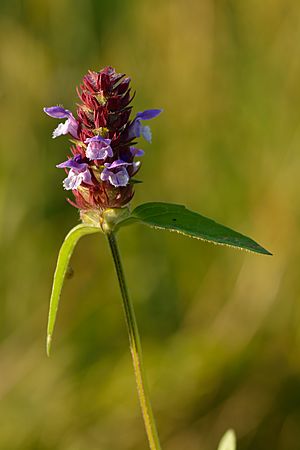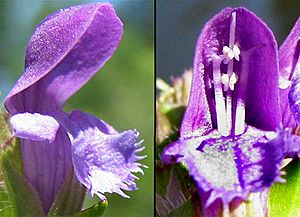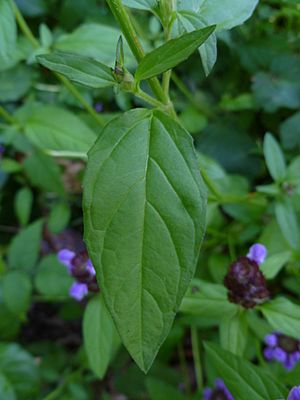Common self-heal facts for kids
Quick facts for kids Common self-heal |
|
|---|---|
 |
|
| Scientific classification | |
| Genus: |
Prunella (plant)
|
| Species: |
vulgaris
|
Prunella vulgaris is a common plant known by many names like common self-heal or heal-all. It is a type of herb that grows in many parts of the world. People have used it for a long time. You can even eat its young leaves and stems raw in salads. The whole plant can be boiled and eaten like a vegetable.
Contents
What it Looks Like
Prunella vulgaris usually grows about 5 to 30 cm (2 to 12 inches) tall. It has reddish stems that are square-shaped. These stems can creep along the ground and grow roots at different points.
Its leaves are shaped like a spear, with jagged edges. They are often reddish at the tips. Each leaf is about 2.5 cm (1 inch) long and 1.5 cm (half an inch) wide. They grow in pairs on opposite sides of the stem. Each leaf has 3 to 7 veins that spread out from the middle. The leaf stalks are usually short, but can be up to 5 cm (2 inches) long.
The flowers grow in a tight, somewhat square bunch at the top of the stem. Just below this bunch, there are two leaves that stick out like a collar. The flowers have two "lips" and are shaped like a tube. The top lip is a purple hood, and the bottom lip is often white. It has three parts, with the middle part being larger and frilly. These flowers usually bloom in the summer, from June to August in many places.
This plant can spread in two ways. It can grow from seeds, or it can spread using its creeping stems that root as they grow.
There are two main types of Prunella vulgaris: var. vulgaris and var. lanceolota.
Where it Grows
Prunella vulgaris is a plant that lives for many years. It is originally from Europe, Asia, Africa, and North America. You can find it in most places with a mild climate. In the 1800s, it was brought to many new countries. It has spread widely in the Pacific Islands, including Australia, New Zealand, and Hawaii. In Ireland, it is very common. This herb also grows in Kashmir, where it is called kalyuth. People there boil it in water and use it to wash and bathe to help with muscle pain.
Where it Lives
You can often find Prunella vulgaris along roadsides, in gardens, and in empty lots. It also grows at the edges of woodlands. It prefers soils that are basic or neutral.
How People Use It
Prunella vulgaris is safe to eat. You can use it in salads, soups, and stews. You can also boil it and eat it like other leafy greens. The Nlaka'pamux people, a Native American group, used to drink a cool tea made from the whole plant as a regular drink.
Many traditional cultures have used this plant to help with different body aches and pains.
What its Name Means
The name Prunella comes from 'Brunella'. This word comes from "die Bräune", which is the German name for quinsy. Quinsy is a type of throat swelling that this plant was historically used to treat.
The word Vulgaris means 'usual', 'common', or 'widespread'.
See also
 In Spanish: Consuelda menor para niños
In Spanish: Consuelda menor para niños



